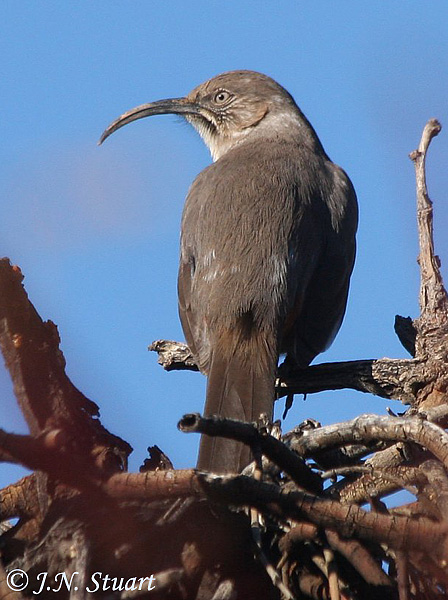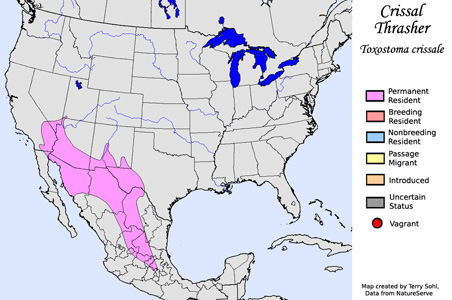| Length: 11.5 inches | Wingspan: 12.5 inches | Seasonality: Non-resident in South Dakota |
| ID Keys: Long strongly decurved bill, grayish overall, rufous undertail coverts, plain face with dark and light malar stripes | ||
 The
Crissal Thrasher is a difficult bird to see in the arid Southwest of the
United States, due to their preference for nesting and foraging in dense
vegetative cover. They are most often seen foraging on the ground
under dense brush, but occasionally in the spring, males may be seen on
rather open perches, singing. Of the other thrasher species in the
desert southwest, the Crissal Thrasher has the most curved bill, but
otherwise, the plumage and structure can look quite similar to the Le
Conte's Thrasher or California Thrasher.
The
Crissal Thrasher is a difficult bird to see in the arid Southwest of the
United States, due to their preference for nesting and foraging in dense
vegetative cover. They are most often seen foraging on the ground
under dense brush, but occasionally in the spring, males may be seen on
rather open perches, singing. Of the other thrasher species in the
desert southwest, the Crissal Thrasher has the most curved bill, but
otherwise, the plumage and structure can look quite similar to the Le
Conte's Thrasher or California Thrasher.
Habitat: Found in arid areas of very thick brush, such as thickets of mesquite or chaparral.
Diet: Feeds mostly on insects, but will also take fruits and berries in season. They will on occasion eat very small vertebrates such as small lizards.
Behavior: Forages by walking on the ground, using its long bill to dig on the ground or probe debris in search of insects.
Nesting: The nest of a Crissal Thrasher is a large cup of twigs and thorns, lined with softer vegetative material. It is placed in dense shrubs like mesquite, usually quite low to the ground. The female lays 2 or 3 eggs, and both parents help to incubate them. Upon hatching, both parents help to raise the young. Crissal Thrashers often raise 2 broods in a breeding season.
Song: Series of musical phrases with abrupt notes interspersed
Migration: Considered a permanent resident throughout its normal range. They are not known to wander far from their normal range.
Interactive eBird Map: Click here to access an interactive eBird map of Crissal Thrasher sightings
Similar Species: California Thrasher, Le Conte's Thrasher, Curve-billed Thrasher
Feeders: Will sometimes attend feeders for fruits and berries.
Conservation Status: Populations appear to be stable, and the IUCN lists the Crissal Thrasher as a species of "Least Concern".
Further Information: 1) USGS - Crissal Thrasher
2) Audubon Guide - Crissal Thrasher
3) WhatBird - Crissal Thrasher
Photo Information: Photo taken by J.N. Stuart - December 27th, 2010 - Sunset Park, Las Vegas - Photo licensed under Creative Commons Attribution NonCommercial NoDerivs 2.0 Generic License.
| Click below for a higher-resolution map |
 |
| South Dakota Status: Non-resident in South Dakota |
